IS BORN
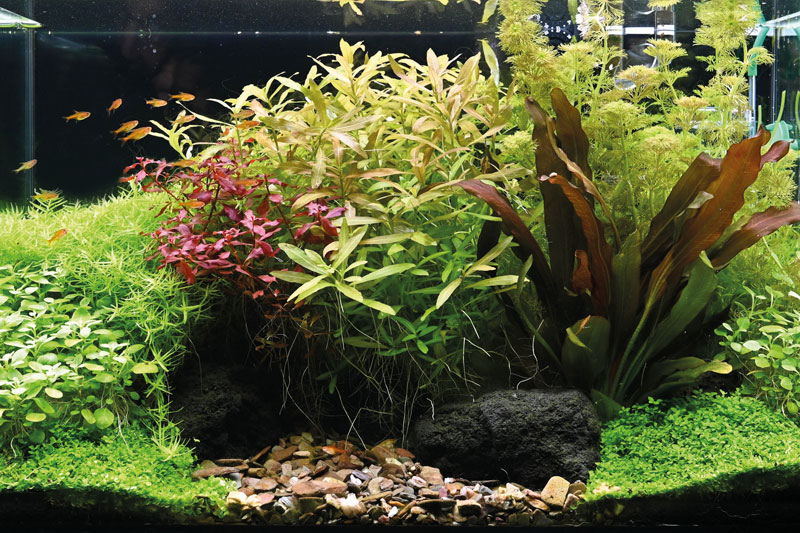
The decision has been made:
An aquarium should beautify our living space with a magnificent underwater world.
As banal as it may sound, the first consideration is the right location in the room. In order to prevent excessive algae growth, an aquarium should not be exposed to direct sunlight. Depending on the fish stock, a spot directly next to a door could also be too busy for the animals. Ideally, you should choose a quiet corner in the room – this, along with comfortable seating, is the ideal solution for viewers. Certain technical requirements, such as sockets and a nearby water connection, should also be taken into consideration.
Aquariums are available in all sizes. Nano aquariums fit on almost any desk, on the kitchen counter, or on the sideboard in the living room. If you have more space, you can choose standard aquariums up to 500 L from the large assortment offered by various suppliers. The weight of a fully equipped aquarium should not be underestimated. A 250-liter aquarium can weigh 400-500 kg! Therefore, the load-bearing capacity of the floor should be carefully considered.
In the following Step by Step guide, you will witness the first few weeks of a newly set up aquarium and how the aquarium develops toward balance, from an initially sterile environment. We opted for a typical beginner aquarium with a length of 60 cm to represent all sizes.
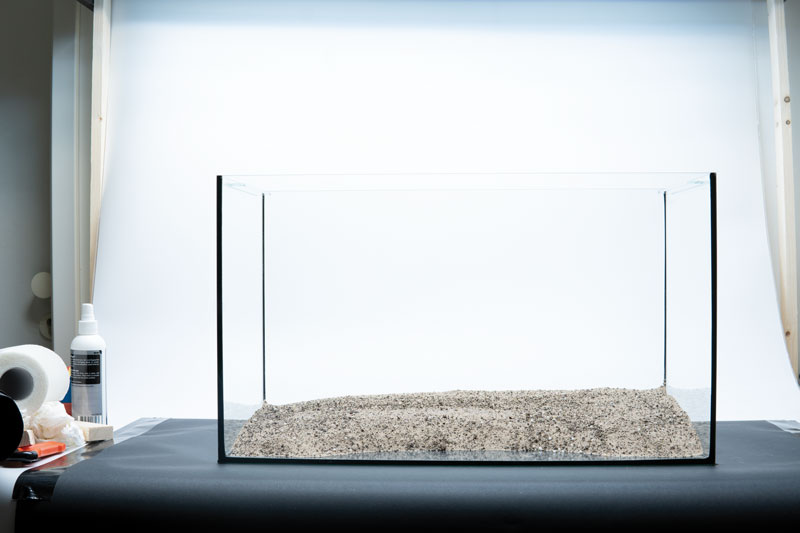 Step 1
Step 1
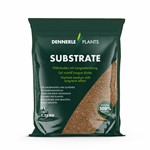 Setting up an aquarium always begins with the foundation of the substrate. The bottom layer consists of the "nutrient medium". It ensures that the plants have an optimal supply of vital nutrients. A height of 5-10 cm for this layer is optimal. No nutrient medium is spread in the middle of the foreground, because it will be covered with cosmetic gravels.
Setting up an aquarium always begins with the foundation of the substrate. The bottom layer consists of the "nutrient medium". It ensures that the plants have an optimal supply of vital nutrients. A height of 5-10 cm for this layer is optimal. No nutrient medium is spread in the middle of the foreground, because it will be covered with cosmetic gravels.

Step 2
 Now, the nutrient medium should be covered with quartz gravel. Slightly sloping the gravel toward the back makes it easier to arrange the plants in later stages. Dennerle quartz gravel is available in different natural colors, depending on taste and preference. A grain size of 1-2 mm suits bottom- dwelling fish. Rounded grains also protect the aquarium inhabitants from injuries.
Now, the nutrient medium should be covered with quartz gravel. Slightly sloping the gravel toward the back makes it easier to arrange the plants in later stages. Dennerle quartz gravel is available in different natural colors, depending on taste and preference. A grain size of 1-2 mm suits bottom- dwelling fish. Rounded grains also protect the aquarium inhabitants from injuries.

Step 3
Matching stone material is placed into the aquarium as a natural design element. You should push the stones deep into the gravel for a natural look. Planthunter natural gravel is strewn in the front-center. No plants should grow here later! Due to the different colors and shapes, sections can be individually designed to create exciting contrasts.
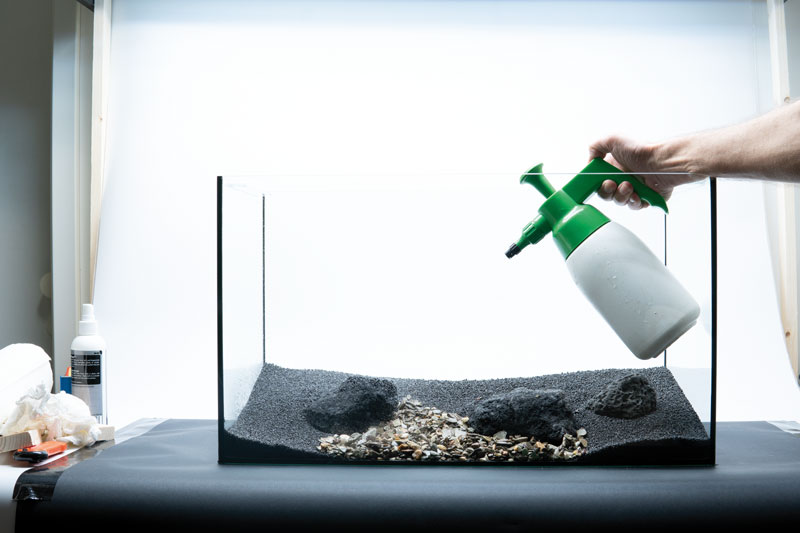
Step 4
The bed structure should be adequately moistened with the help of a spray bottle. This achieves a certain "sticking effect" that will ease the planting process.
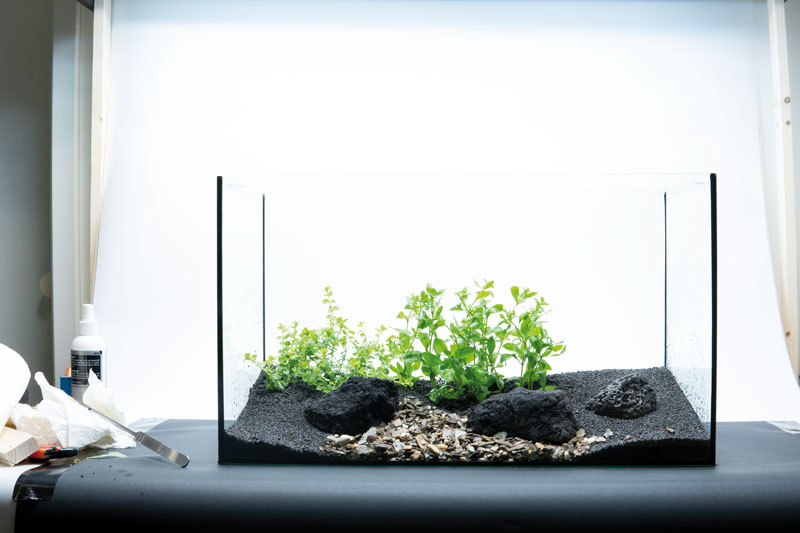
Step 5
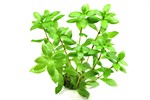 The first two background plants Rotala sp. 'Green' and Hygrophila polysperma are planted. They are Easy category fast-growing stem plants and a perfect choice for the background of this 60cm Aquarium.
The first two background plants Rotala sp. 'Green' and Hygrophila polysperma are planted. They are Easy category fast-growing stem plants and a perfect choice for the background of this 60cm Aquarium.
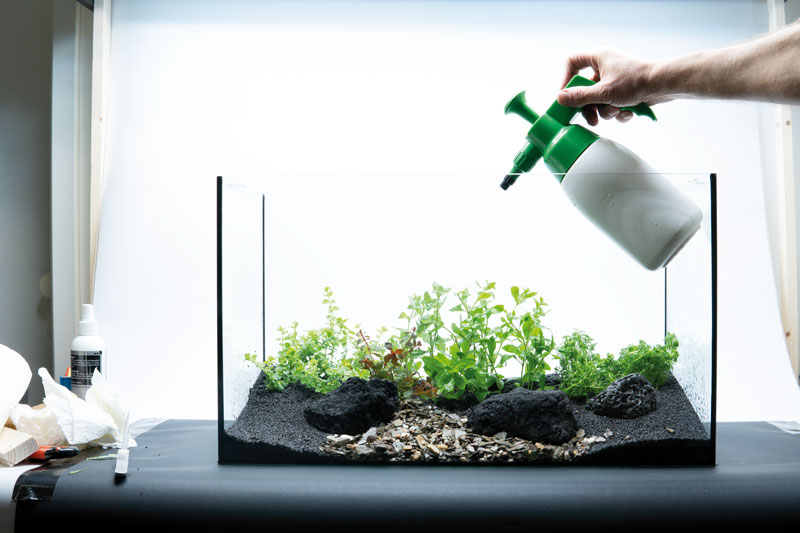
Step 6

Limnophila sessiliflora is added on the right. The red-leaved stem plant, Ludwigia palustris 'Super Red', is added to the midground. Since the plants are not yet under water, the seedlings should be moistened repeatedly.
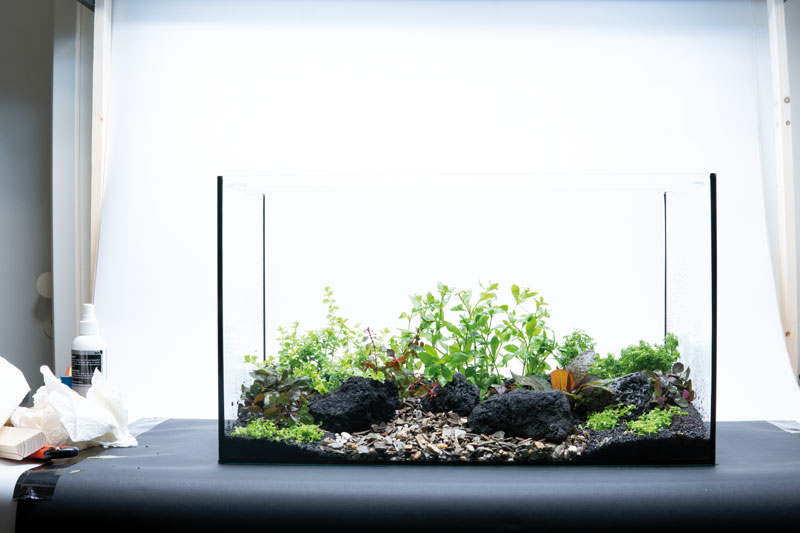
Step 7
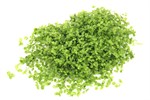
Now the rest of the plants are planted: Lobelia cardinalis 'Mini' and Echinodorus 'Red Chameleon' for the midground. The beautiful, flat-growing plant Micranthemum tweediei 'Montecarlo' for the foreground. In general, when setting up a new aquarium, it is important to use a high percentage of fast-growing plants. They provide protection against unwanted algae growth!
Tip: Another rule of thumb is to cover a minimum of 80% of the ground with plants!
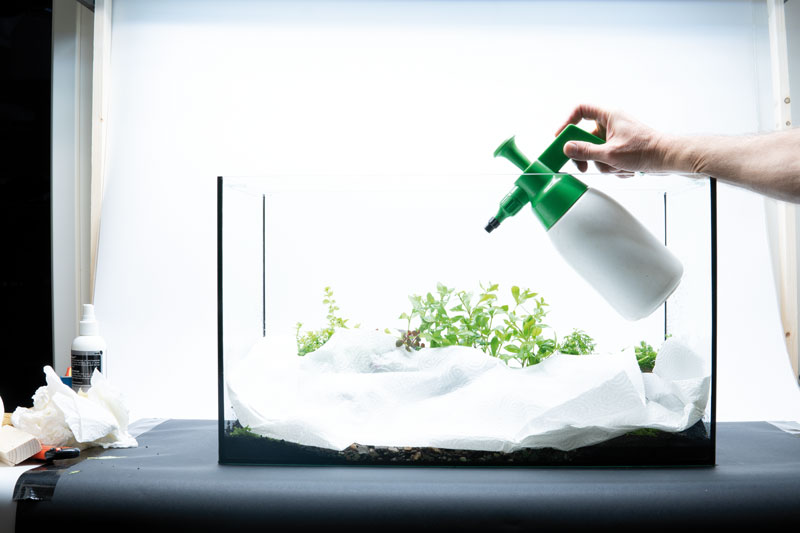
Step 8
The finished plantings are now covered with a damp paper towel, so that there is close contact with the composition and to avoid a whirled-around substrate when the water is added.
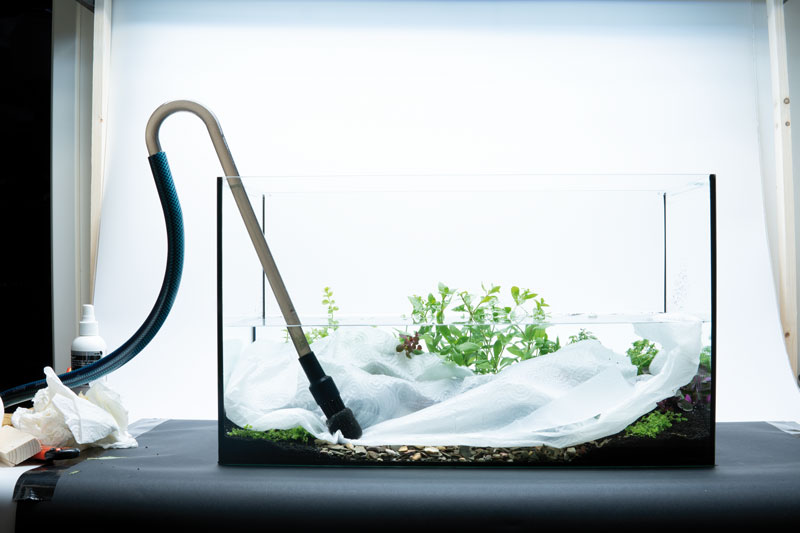
Step 9
Now, the aquarium can be filled slowly with tempered water using a hose or a watering can. Be careful and take your time during this process. The more time you take, the clearerthe water will be after this process.
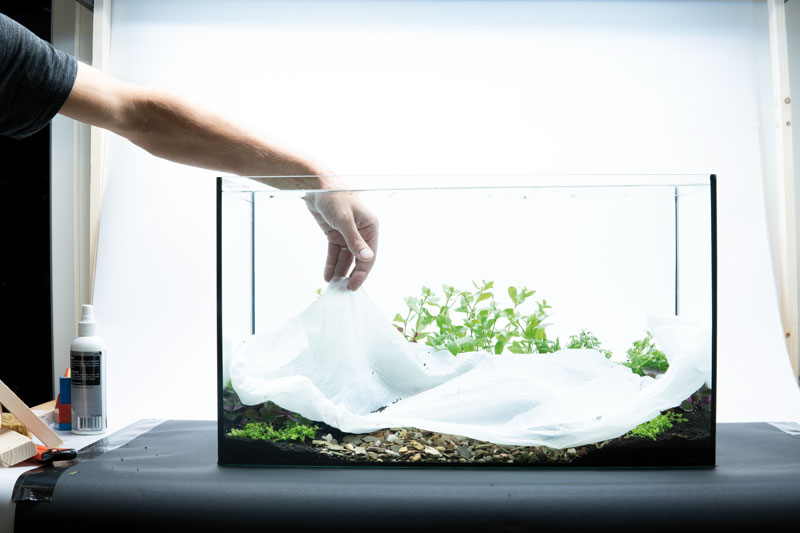
Step 10
Leave the paper towel in the aquarium until it is completely filled. Then, carefully remove it.

Step 11
The freshly filled aquarium can now be equipped with technology such as filters, lighting, heaters, and, depending on your choice, a pressurized CO2 system.
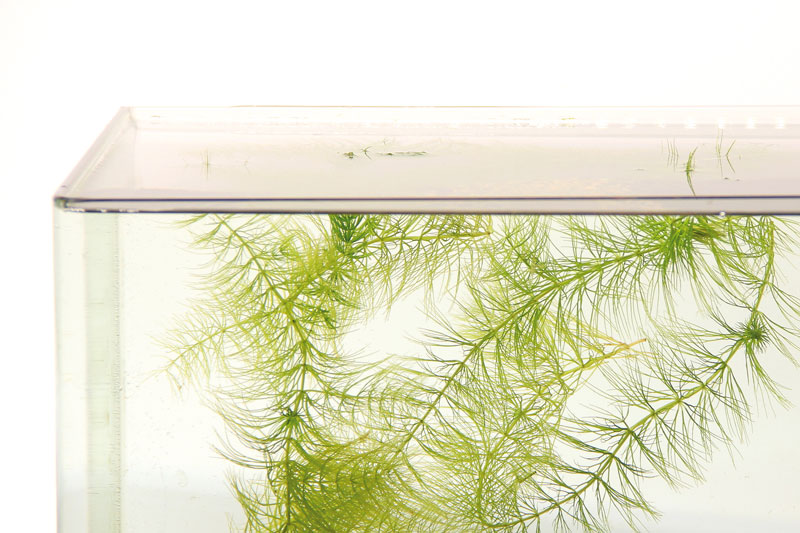
Step 12
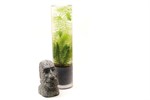 The horn herb Ceratophyllum demersum is considered a green weapon against algae! It grows freely and very quickly in water and ensures that excess nutrients are absorbed. Thus, the plants can grow in peace, ensuring a biological balance in the aquarium. Alternatively, you can choose from our range of floating plants.
The horn herb Ceratophyllum demersum is considered a green weapon against algae! It grows freely and very quickly in water and ensures that excess nutrients are absorbed. Thus, the plants can grow in peace, ensuring a biological balance in the aquarium. Alternatively, you can choose from our range of floating plants.
Tip: Once the horn herb has done its job, you can take it out of the aquarium and put it in a large flower vase for a nice decoration in your apartment!
Bacteria
Just like in nature, microorganisms are the key to a successful aquarium. Therefore, the fresh water should be enriched with a highly effective filter bacteria product.

Fertilization and water care
With the help of a bio-Co2 system, plant-growth success can be achieved after just a few weeks!

Water change
When setting up a new aquarium, a 30-50% water change every 3-4 days is highly recommended for the first 2 weeks. After a few weeks, the ecosystem has settled in and a weekly water change of approx. 20-30% is sufficient. The gravel cleaner is a good tool for the maintenance routine.
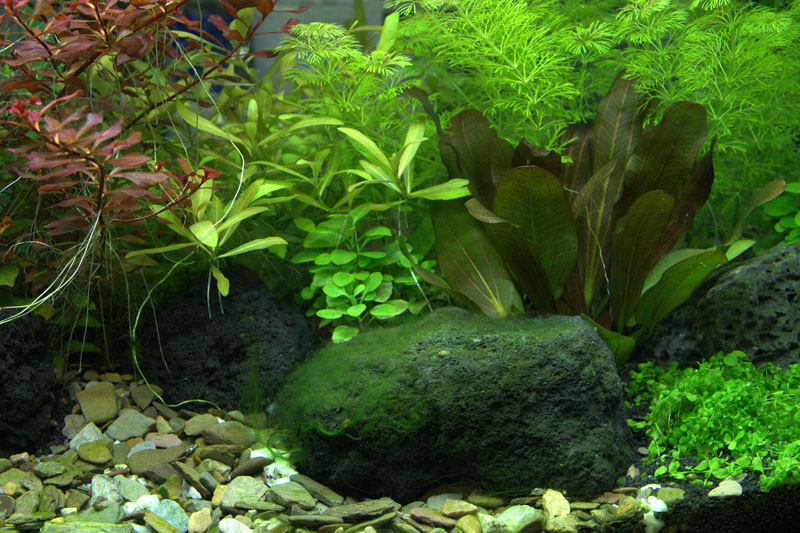
Algae are growing
During the first weeks of the start-up phase, the appearance of algae is completely normal. The aquarium
is not yet properly in balance – all of the important elements are not yet working in harmony. For more information about Algae, check out our in-depth Algae Guide.

The first animals move in
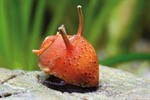 After about 10-14 days, you can insert the first algae-eating animals such as Otocinclus catfish, shrimp and snails. This animal stock immediately helps protect against the growth of algae!
After about 10-14 days, you can insert the first algae-eating animals such as Otocinclus catfish, shrimp and snails. This animal stock immediately helps protect against the growth of algae!

Now the fish are coming
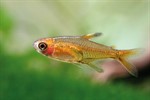 Twenty fish Hyphessobrycon amandae are inserted into this 60 cm aquarium. Place the fish transport bag on the water surface so that the temperature of the water in the bag can adjust. Bit by bit, it should be filled with aquarium water. After about half an hour, the fish can be released into the aquarium.
Twenty fish Hyphessobrycon amandae are inserted into this 60 cm aquarium. Place the fish transport bag on the water surface so that the temperature of the water in the bag can adjust. Bit by bit, it should be filled with aquarium water. After about half an hour, the fish can be released into the aquarium.
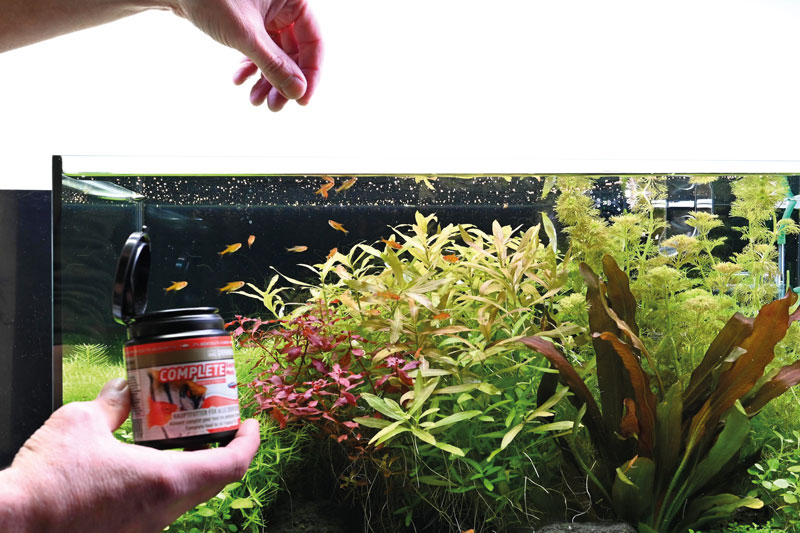
Feeding
A high-quality and healthy diet is very important for fish and other aquarium inhabitants. Food should be selected that corresponds to the natural diet of the aquarium fish. It should help regulate their digestion, minimizing water pollution while protecting the biological balance.
Tip: Feed twice as much as the fish eat in 2-3 minutes.
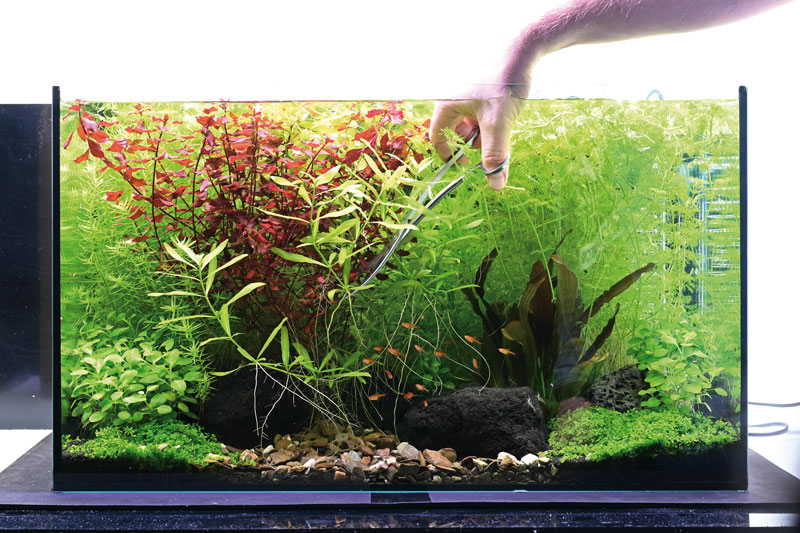
Pruning
Most of the stem plant species are fast growing and therefore need to be trimmed regularly. Generally, the stronger the pruning, the more compact the growth. The aquarium appears less attractive for a few days after pruning. After a short period of time, the plants will grow back and look even more beautiful and impressive.
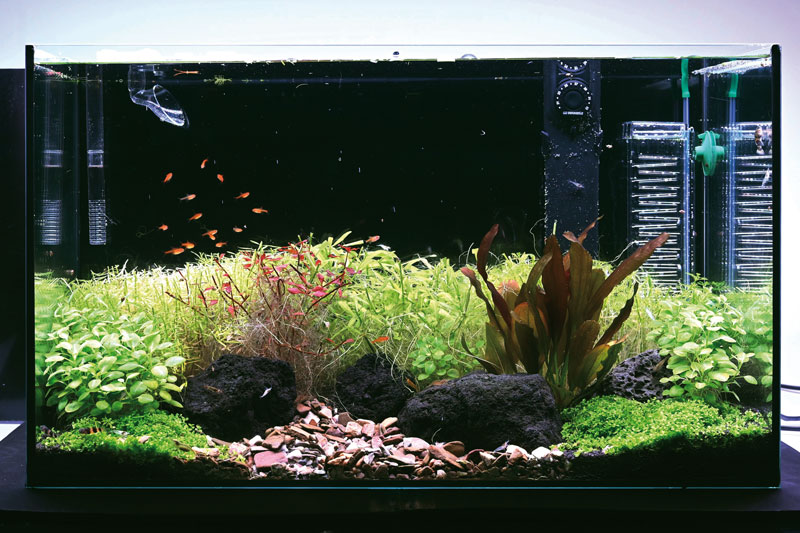
As long as you follow the guidelines above, you are all set to enjoy your beautiful water world.
_____________
Check out the following layouts for more inspiration: